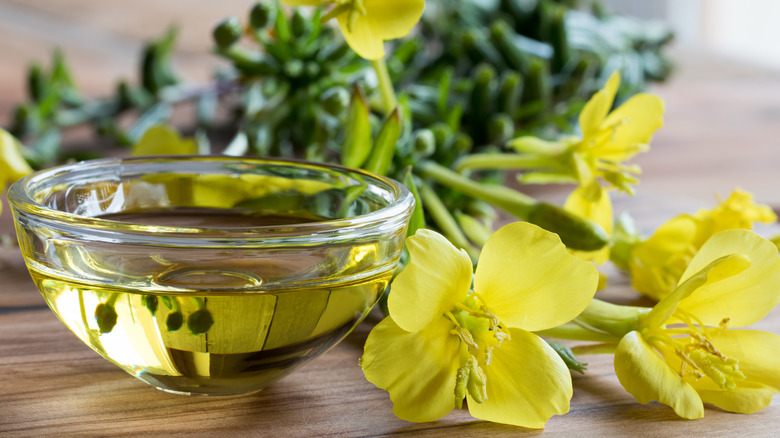What Evening Primrose Oil Can Do For Your Hair
Evening primrose oil (EPO) isn't anything new. It has been used for hundreds of years by cultures, such as Native Americans, who harvested the flowering plant for medicinal purposes. If you've ever had a child or know someone who has, you might have heard EPO come up as one of the ways to induce labor. It also has been used to reduce PMS symptoms, remedy gastrointestinal upset, soothe sore throats, and treat eczema (atopic dermatitis).
It's clear that this plant is thought to pack a punch, and scientists attribute this to its high gamma-linolenic acid (GLA) content. As an omega-6 fatty acid, GLA may help with many bodily functions like brain function, skeletal health, metabolism, and — of course — skin and hair growth.
In fact, it is rumored to be so good for hair that it is touted as a hair loss treatment by respected medical databases. However, its effectiveness is still debated. But even if it can't grow you a full head of hair overnight, EPO's hair-health-boosting benefits are pretty impressive.
An age-old secret
Today's research on EPO's effect on hair and hair loss is limited. Nevertheless, the plant has been used for centuries as a medicinal treatment for a variety of issues. The studies that we do have show that the oil may be a way to promote hair growth, reduce hair follicle and scalp damage, and relieve oxidative stress.
Its mystifying hair growth properties might be linked to one important compound: Arachidonic acid. This substance does double duty for your tresses, promoting the growth of existing hair shafts as well as stimulating new growth. The first compound we mentioned, gamma linoleic acid (GLA), comes into play too. It's an excellent anti-inflammatory that might help relieve damage to the scalp and hair follicles. It is also excellent for atopic dermatitis of the scalp.
Finally, it's full of the antioxidant Vitamin E. Antioxidants are the free radical fighters of the body. Oxidative stress is an imbalance between these free radicals and antioxidants. In a very scientific process that involves molecule donation and stability, antioxidants neutralize free radicals and combat the negative effects of oxidative stress, which can include hair loss and weakness.
How to use EPO for hair
Evening primrose oil is commonly used in two ways – either orally or topically. The best method for you depends on your concerns and desired results.
If you think oxidative stress or hormones may be to blame for your hair damage and loss, you might want to take EPO by mouth. The best way to do this is with an EPO supplement. There are many options, and we can't tell you which one might be best — but we can say that it's important to read the labels carefully and have a conversation with your doc before starting any new supplement. This is especially true because the U.S. Food and Drug Administration (FDA) doesn't regulate herbal supplements.
Topical application can be helpful for atopic dermatitis or scalp irritation. First, find a pure EPO product, (not essential oil of evening primrose) then do a patch test on your skin to check for a reaction. If you're good to go, apply it directly to your dry hair. Place the oil onto your palms and rub it to generate warmth. Next, start at the scalp and hair roots, massaging it into the skin and throughout your hair. Let your hair soak up the goodness for thirty minutes before rinsing it. Evening primrose oil can take up to six weeks to work, though some notice a difference in one to two weeks. If eight weeks have passed with no change in your condition, it may be time to contact your dermatologist.


